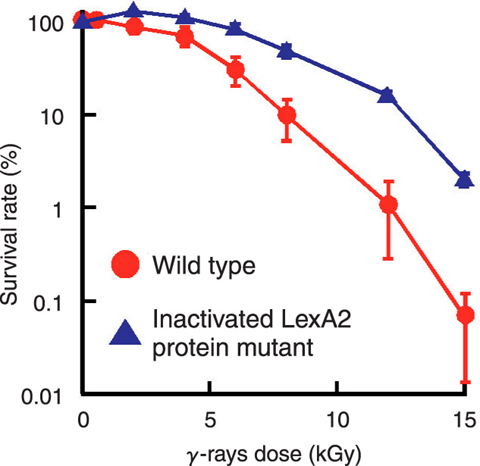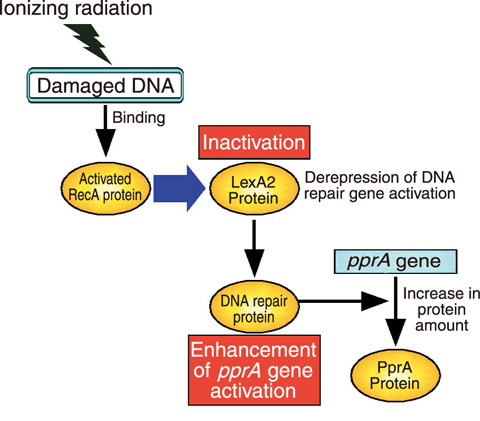
Fig.4-10 Survival curves for γ-rays

Fig.4-11 The radiation response mechanism of Deinococcus radiodurans
The radiation response of microorganisms including their DNA repair mechanisms have actively been studied using Escherichia coli from 1970's. It is well known that E. coli possesses a mechanism of increasing the intracellular level of DNA repair proteins following radiation-induced DNA damage. RecA ( Recombinase) and LexA (Locus for X-ray sensitivity) proteins play important roles in the DNA damage response and repair mechanisms in E. coli. On the other hand, we made clear that RecA protein contributes to the radiation response mechanism of the radioresistant bacterium Deinococcus radiodurans, but LexA protein is not involved. Furthermore, we identified a novel DNA repair-promoting protein PprA (Pleiotropic protein promoting DNA repair), which plays a critical role in the radioresistance. However, the relationship between RecA and PprA proteins in the radiation response mechanism remained to be elucidated.
D. radiodurans possesses LexA2 protein which has amino acid sequence similar to LexA. Integrating bioinformatics and molecular biology, we generated an inactivated LexA2 protein mutant strain and confirmed that the radioresistance of D. radiodurans was increased by the inactivation of LexA2 protein (Fig.4-10). In 1999, the whole genomic DNA sequence of D. radiodurans was published by The Institute for Genome Research, USA. We found that there was an error in the published sequence of lexA2 gene region. There have been several studies performed based on the wrong sequence. After determining the correct lexA2 DNA sequence, we investigated the characteristics of LexA2 protein that has the correct amino acid sequence in detail. As a result, we found that RecA protein is activated by its binding to damaged DNA. The interaction of activated RecA and LexA2 proteins resulted in inactivation of LexA2 protein as a repressor. Activation of DNA repair genes regulated by LexA2 protein was then derepressed. Consequently, activation of pprA gene was enhanced by this derepression, and thereby the intracellular level of PprA protein was increased (Fig.4-11). Thus, the increase in radioresistance of the inactivated LexA2 protein mutant strain is explained in part by this series of events.
Currently, PprA protein is being commercialized as a highly efficient DNA repair reagent. The results of this research should be applicable to improve the production efficiency of PprA protein in a manufacturing process. In future, by analyzing the crystal structure of a DNA repair protein complex, molecular mechanism of protein-protein interaction will be made clear in detail. This will lead to the development of drug discovery science using novel DNA repair protein complexes of great use for advanced medicine.